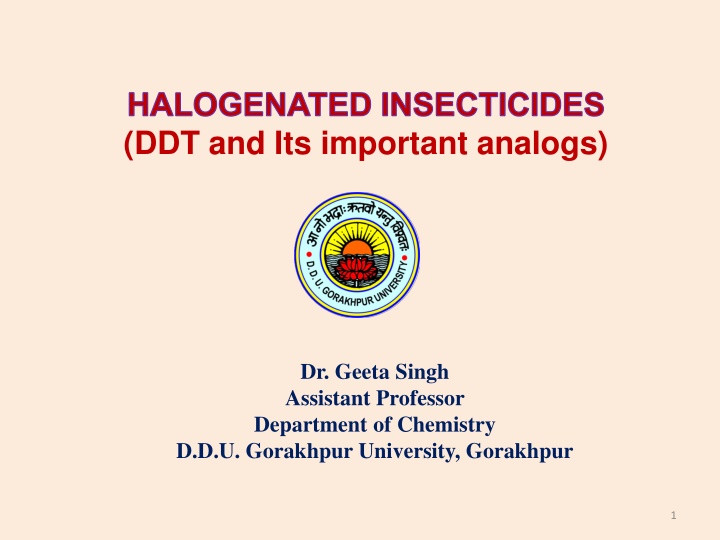
Halogenated Insecticides: DDT and Its Important Analogs Overview
Explore the world of halogenated insecticides, focusing on DDT and its analogs like DFDT, DMDT, and DDD. Learn about their synthesis, applications, properties, and the environmental impact of these organochlorine pesticides.
Download Presentation

Please find below an Image/Link to download the presentation.
The content on the website is provided AS IS for your information and personal use only. It may not be sold, licensed, or shared on other websites without obtaining consent from the author. If you encounter any issues during the download, it is possible that the publisher has removed the file from their server.
You are allowed to download the files provided on this website for personal or commercial use, subject to the condition that they are used lawfully. All files are the property of their respective owners.
The content on the website is provided AS IS for your information and personal use only. It may not be sold, licensed, or shared on other websites without obtaining consent from the author.
E N D
Presentation Transcript
HALOGENATED INSECTICIDES (DDT and Its important analogs) Dr. Geeta Singh Assistant Professor Department of Chemistry D.D.U. Gorakhpur University, Gorakhpur 1
Halogenated Insecticides Organochlorine pesticides (OCP) are synthetic pesticides widely used all over the world. They belong to the group of chlorinated hydrocarbon derivatives, which have vast application in the chemical industry and in agriculture. These compounds are known for their high toxicity, slow degradation and bioaccumulation. The aliphatic or aromatic halogenated compounds which may be used to kill the insects are known as halogenated insecticides. The main types of halogenated insecticides are halogenated alkanes, BHC and its isomers, DDT and important analogs ( DFDT, DMDT, DDD).
DDT (p,p-Dichlorodiphenyl trichloroethane) IUPAC name is 1,1-Bis(4-chlorophenyl)-2,2,2-trichloroethane Nobel Prize In Physiology or Medicine 1948 Paul Hermann M ller,
Synthesis It was first synthesized by Othman Zeidler in 1874 but its insecticidal properties were discovered by Paul Muller in 1939. It may be prepared by condensation of chlorobenzene and chloral (trichloroactaldehyde) in presence of conc. H2SO4.
Application and Properties It is colorless, odourless crystalline solid and a M.P. of 108-109 0C It is practically insoluble in water but soluble in many organic solvents such as Acetone, benzene, carbon tetrachloride etc.. DDT is one of the most persistent and durable of all contact insecticides because of its low water solubility, low vapor pressure and high fat solubility. DDT is effective insecticide particularly for mosquito, flies and other crop pests. DDT is also effective in the control of other diseases like yellow fever, dengue, encephalitis and plague. It is toxic to human and other animals, birds, fishes. However its use as insecticide has been banned in most of the developed and developing countries.
DMDT( p,p-Dimethoxydiphenyltrichloroethane) (Methoxychlor) IUPAC name is 1,1-Bis(4-methoxyphenyl)-2,2,2-trichloroethane
Synthesis It may be prepared by condensation of anisole with chloral in presence of conc. H2SO4.
Application and Properties DMDT is white crystalline solid M.P. 890C. Its insecticidal property is similar to DDT. It is insoluble in water but soluble in several organic solvents. It is stable and does not decompose easily, DMDT is less toxic than DDT. It was used to protect crops, livestock and pets against flies. It was synthesized for replacement of DDT but banned due to its bioaccumulation and acute toxicity
DFDT (p,p -Difluorodiphenyltrichloroethane) IUPAC name is 1,1-Bis(4-fluorophenyl)-2,2,2-trichloroethane
Synthesis It may be prepared by condensation of fluorobenzene and chloral (trichloroactaldehyde) in presence of conc. H2SO4.
Application and Properties DFDT is crystalline solid M.P. 44-450C. It possess sweet smell but it is less effective than DDT. It is florine anologue of DDT and less toxic to animal and fish than DDT and more toxic to flying insects.
DDD (p,p -Dichlorodiphenyldichloroethane) IUPAC Name 1,1-Bis(4-chlorophenyl)-2,2,-dichloroethane
Synthesis It may be prepared by condensation of chlorobenzene and dichloroactaldehyde in presence of conc. H2SO4. less toxic and less effective than DDT. However all these derivatives are referred as analog of DDT. Its insecticidal property is related to DDT but it is
